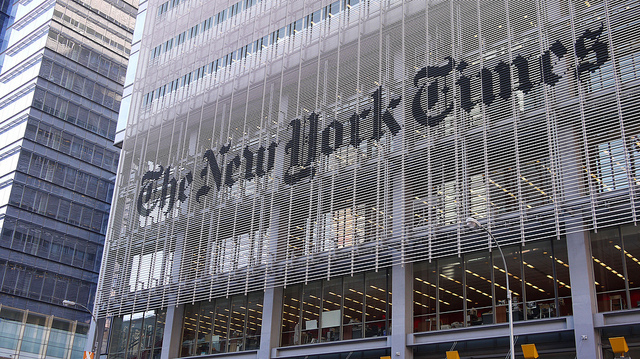
Here are the top five points from Thompson’s talk (which can be listened to as a webcast here).
That’s an astounding run rate, by some measures 10× the rate of a year ago. Those new subscriptions are overwhelmingly digital, and may add $30 million or more to the Times’ top-line revenue — hugely needed,as the Times saw an 18 percent decrease in print advertising in the third quarter.
Donald Trump’s election drove a surge after Nov. 8. Even before that, though, the Times had doubled its subscription run rate in the third quarter; that’s the power of its journalism and its analytic smarts at converting semi-regular readers to subscribers. Further, the Times has toughened its relationship with Facebook. Visitors clicking on Times links from Facebook used to be able to read freely; now they hit the Times paywall after reading 10 articles. The Times has also cut back on its participation in Facebook Instant Articles. (I wrote more about this here.)International subscribers make of 13 percent of the Times’ total subscription base, Thompson said. While that percentage has held fairly steady, the number of international digital subscribers — nearing 200,000 — is notable. Given the big Trump-related surge in U.S.-based subscriptions, the fact that the international percentage is remaining steady is encouraging for the Times in the longterm; non-U.S. growth is a major long-term driver of the Times’ new reader-revenue-plus-digital-ads strategy.
22 percent of the Times’ overall revenue now comes from print advertising, indicating a reduced reliance on the category of revenue that has brought the most woe to newspaper-based businesses. Or, in Thompson’s MBA-speak: “We’re seeing deleveraging and degearing of print ads.” The impact is clear: With more revenue reliance on the parts of the parts of the business that are growing, and less on what’s dying off, transformation is indeed possible.At last year’s conference, Thompson had projected that the Times could “close to double” its native content business ($35 million in 2015) in 2016. Asked Monday if the company is on track to do that, Thompson said no. “It has not grown as strongly as I wanted,” he said, though he indicated the business is still increasing significantly.
Thompson cited the Samsung 360º campaigns, and talked about the advertiser relationships now expected in the high-end marketplace. “CMOs are thinking differently. They don’t want to talk about ‘advertising.’ We’re now selling white space…blank space.”
Branded content revenue forms an absolute priority for the Times and its national peers, as digital display advertisers continues to see both downward pricing pressures and duopolistic domination by Google and Facebook. Amid the highly encouraging digital subscription sales, the Times must assess how much branded content can grow further in the next couple of years.
That’s the number Thompson tossed out — I believe for the first time — on Monday. “I think the ambition of having 10 million digital subscribers is possible for us.” Of course, he didn’t set a timeline. Yet that number tells us something about the new landscape for the smartphone-centric Times. The Times’ share price — already up 20 percent since June — increased around 3 percent Monday, as analysts and investors apparently liked the growth story they heard.